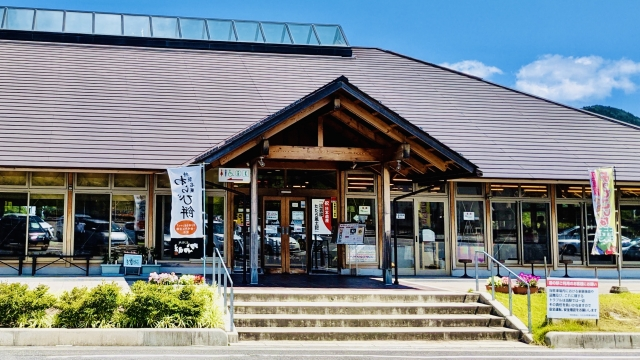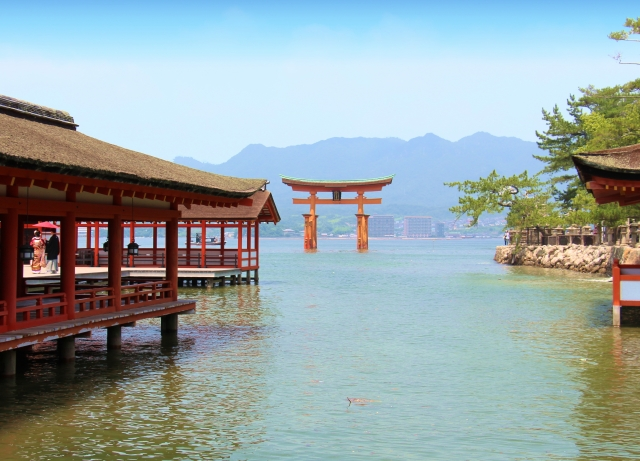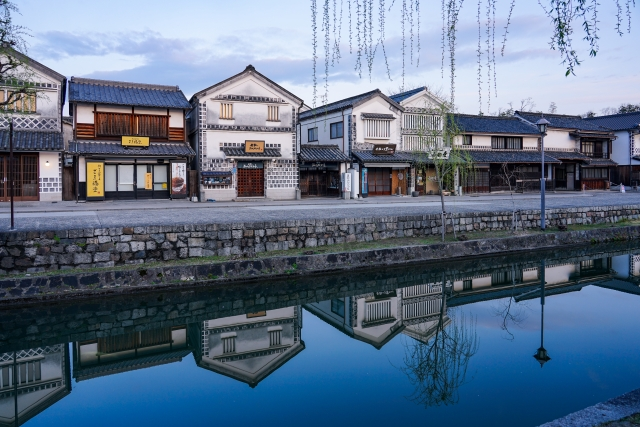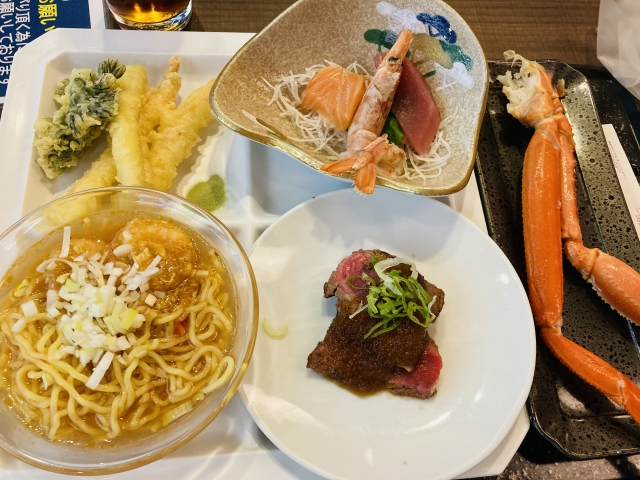The Chugoku Region is located in the western part of Honshu, Japan. The north faces the Sea of Japan, which can be rough in winter, and the south faces the Seto Inland Sea, which is calm all year round. For this reason, each prefecture has its own unique cuisine and tourist spots with beautiful scenery. Read this article that introduces you to places you should visit in Chugoku and food specialties you should try on your next Chugoku trip.
Table of Contents
Chugoku Region has 5 Prefectures

The Chugoku region is located in the western part of Honshu (本州; Japan main iland), and consists of 5 prefectures: Hiroshima, Okayama, Tottori, Shimane, and Yamaguchi. The north side is called the "Sanin Region (山陰地方 sanin chihou)", and the south side is called the "Sanyo Region (山陽地方 sanyou chihou)". The two regions are separated by the Chugoku mountains.
In the Chugoku region, the climate differs greatly between the Sanin and Sanyo regions. The Sanin region, which faces the Sea of Japan, is affected by seasonal winds from the northwest in winter. This causes sharp temperature drops and heavy snowfall. On the other hand, the Sanyo region, which faces the Seto Inland Sea, is warm throughout the year and does not rain often.
In the next part, we will introduce the characteristics of each of Chugoku’s prefectures.
Hiroshima Prefecture 広島県

Hiroshima Prefecture faces the Seto Inland Sea. Hiroshima City, the prefectural capital, has the largest population in the Chugoku region. The heavy industry, electric components, and other manufacturing sectors are doing well. Citrus fruits and oysters are also being cultivated.
Hiroshima is where the world's first atomic bomb was dropped and suffered devastating damage. At the Atomic Bomb Dome, Peace Memorial Park, and Hiroshima Peace Memorial Museum near the hypocenter, you can feel the fear of nuclear weapons and the importance of peace.
Recommended Reading:
Okayama Prefecture 岡山県

Okayama Prefecture, which faces the Seto Inland Sea, is called the "Land of Sunshine (晴れの国)" because it rarely rains. Blessed with a warm climate and rich nature, production of fruits such as white peaches and muscat is fruitful (pun intended).
Okayama is where you can enjoy a variety of leisure activities. You can enjoy swimming in the ocean and marine sports in the southern part of the prefecture. The northern highlands are famous as summer resorts because it is cool even in summer, whilst in winter, it is popular as a place for winter sports such as skiing and snowboarding.
Tottori Prefecture 鳥取県

Tottori Prefecture is located in the northeastern part of the Chugoku Region, and faces the Sea of Japan. There are many sunny days from spring to autumn, and there are days when it snows in winter. It is a place where you can easily feel the changing of the four seasons. Since it is an area that is barely affected by typhoon disasters, It is easy to arrange and have an undisrupted trip even in summer.
The agriculture industry does very well in Tottori Prefecture. Tottori produces rice, vegetables, and fruits. producing rice, vegetables, and fruits. In particular, their yield of “20th Century Pears (二十世紀梨)” is the highest in Japan.
Shimane Prefecture 島根県

Shimane Prefecture is a prefecture located on the Sea of Japan side. The area facing the sea has a mild climate, and it doesn't snow much even in winter. On the other hand, the inland mountainous areas are severely cold in winter and have heavy snowfall.
The Iwami Ginzan Silver Mine, which is registered as a World Heritage Site, is located in Shimane. It is a mine where silver was mined and processed. You can see remnants of mining tunnels and silver workshops there. If you are interested in world heritage sites, it will be a great place to visit.
Yamaguchi Prefecture 山口県

Located at the western end of the Chugoku Region, Yamaguchi Prefecture prospered as a transportation hub connecting Honshu and Kyushu. Because it faces the Sea of Japan and the Seto Inland Sea, you can enjoy different seascapes and local specialties depending on the area.
Hagi City has a castle town lined with samurai residences from the Edo period, and Iwakuni City has Kintaikyo Bridge, a rare wooden five-arched bridge. There are many historical buildings that are related to the people who were involved in the Meiji Restoration, so it is also recommended for those interested in Japanese history.
※ Japan Meteorological Agency, "中国地方の天候"
Writer's Pick
Famous Sightseeing Spots in Chugoku Region

There are many famous tourist destinations in the Chugoku Region. We have compiled 1 recommended spot for each prefecture. You can use it as a reference when sightseeing.
Itsukushima Shrine (Hiroshima Prefecture)

Itsukushima Shrine, located in Miyajima, Hiroshima Prefecture, is a shrine that is said to have been built by Emperor Suiko in the year 593. It was registered as a World Heritage Site in 1996. One of its highlights is the symmetrical shrine building called Shinden-zukuri. Although it has suffered through many disasters in the past, it was rebuilt to its original design in 1168. The scenery of the bright vermilion shrine building spreading out over the sea is beautiful and impressive.
Kurashiki Bikan Historical Quarter (Okayama Prefecture)

The Kurashiki Bikan Historical Quarter is a sightseeing spot in Kurashiki City in the southern part of Okayama Prefecture that has mansions and warehouses built over the Edo, Meiji, and Taisho periods lined up. With plaster and tile made namako walls and tiled roof buildings, it is a town that makes you feel as if you have time slipped back to olden Japan with its old towncape sceneries.
Some of the historic buildings operate as restaurants, it would be nice to have a meal in an establishment filled with history. Waterways also run through the town, so if you have time we recommend taking a small boat tour around.
Tottori Sand Dunes (Tottori Prefecture)

The Tottori Sand Dunes on the coast of the Sea of Japan is a tourist spot that has been selected as a National Natural Monument and one of “Japan's Top 100 Geological Features (日本の地質百選)”. It is the largest sand dune that can be seen in Japan, measuring 16km from east to west, and 2.4km from north to south.
At the Tottori Sand Dunes, you can enjoy the magnificent scenery, enjoy camel riding, and paragliding. With the Sand Museum and the Tottori Sand Dunes Children's Country nearby, it is a tourist destination that can be enjoyed by people of all ages.
Izumo Taisha Shrine (Shimane Prefecture)

Izumo Taisha Shrine in Shimane Prefecture is famous for its God of marriage, and is popular with those looking for a good match. It is a historical shrine that is even mentioned in the Kojiki, the oldest history book in Japan. The main shrine was built in 1744 and is designated as a national treasure. The worship hall, which is said to be the largest post-war wooden building, and the Kagura hall, which has an impressive giant shimenawa rope, are also highlights of the shrine.
Akiyoshido Cave (Yamaguchi Prefecture)

The Akiyoshido Cave in Yamaguchi Prefecture is one of the largest limestone caves in Japan. The ground has been eroded by rainwater and groundwater. On the 1km sightseeing course, you can see rocks hanging from the ceiling like icicles and rocks shaped like bronze statues. The temperature in the limestone cave is 17°C/63°F all year round, so it's cool in summer and warm in winter.
Local Cuisine to Try in Chugoku Region

In Japan, local cuisine in each region is passed down through the generations. We will introduce okonomiyaki, octopus rice, persimmon leaf sushi, Izumo soba, and kawara soba as local dishes of the Chugoku Region.
Okonomiyaki (Hiroshima Prefecture)

Okonomiyaki is a dish made by mixing water dissolved wheat flour with cabbage and meat, then grilling it on an iron plate. The okonomiyaki that is eaten in Hiroshima Prefecture is different from other regions in terms of how it is made and the ingredients used, so it is also called "Modanyaki".
Modanyaki is made by layering vegetables and meat on top of a thin cooked layer of batter. Unlike regular okonomiyaki, all the ingredients are not mixed together from the beginning. Another characteristic of modanyaki is that Chinese noodles are added last. It is also usually topped with a fried egg.
Tako-Meshi (Okayama Prefecture)

Tako-meshi is a local dish unique to Okayama Prefecture, which has one of the largest catches of octopus in Japan. It is a dish of chopped octopus and rice cooked in dashi stock, and is said to have been first made by fishermen on boats. The octopus caught in Okayama Prefecture are raised in the fast-flowing waters of the Seto Inland Sea, and are characterized by their firm and chewy texture. Tako-meshi, made with simple ingredients, is a dish where you can enjoy the octopus’s umami and the ocean's scent.
Kakinoha-Zushi (Tottori Prefecture)

Kakinoha-Zushi made in Tottori Prefecture, is a dish of thinly sliced salted trout pressed together with vinegared rice and served on persimmon leaves. The colour contrast between the pink of the trout and the green of the persimmon leaves is vivid which is why it is made for special occasions such as New Year's and festivals since ancient times. By combining salt-pickled trout with persimmon leaves, which have preservation properties, it does not go bad easily, and can be said to be a dish made with the culmination of ancestors’ wisdom.
Izumo Soba (Shimane Prefecture)

Izumo soba, which is eaten in the Izumo region of Shimane Prefecture, is a local dish that is one of ”Japan’s 3 Great Sobas (日本三大そば)”.
The difference between Izumo soba and typical soba noodles is the colour of the noodles. Common soba noodles are made using buckwheat flour that is made from husk-removed buckwheat, and is whiter in colour. Izumo soba is made from buckwheat flour that is grinded from buckwheat still with husks attached which gives it a darker colour, and is said to have a nice smell and texture.
Kawara Soba (Yamaguchi Prefecture)

Kawara soba is a dish of boiled green tea soba that is grilled on a heated roof tile and topped with thin strips of omelette and beef. It is often served with lemon or grated daikon. It is eaten by dipping the soba and other ingredients into sauce.
Kawara soba started from a ryokan in Yamaguchi Prefecture in 1961 and has spread throughout the prefecture. Although it has a short history compared to other local cuisines, it is popular as a local soul food.
Recommended Souvenirs to Get in Chugoku Region
Momiji-manju (Hiroshima Prefecture)

A famous souvenir from Hiroshima Prefecture is Momiji manju, which is shaped like a maple leaf. Other than the regular red bean paste, there are other fillings such as chocolate and custard cream.
Izumo Zenzai (Shimane Prefecture)

Izumo City is said to be the birthplace of zenzai. Zenzai is a dessert made by boiling azuki beans with sugar and adding rice cakes and shiratama dango. It is recommended for people who like Japanese sweets. Izumo zenzai is sold in bags as well.
Traditional Crafts

The Chugoku Region is also famous for its traditional crafts. Pottery such as Bizen ware (備前焼) from Okayama Prefecture and Hagi ware (萩焼) from Yamaguchi Prefecture, and Japanese paper like Inshu Washi (因州和紙) from Tottori Prefecture are souvenirs that represent Japanese traditional culture.
Summary

The Chugoku Region consists of Hiroshima, Okayama, Tottori, Shimane, and Yamaguchi prefectures. Each prefecture has its own unique geographical features and climate. You can enjoy beautiful scenery and a variety of local food specialties. There are many sightseeing spots that have been registered as national treasures and World Heritage Sites. If you are planning to cover the whole of Japan, don’t miss Chugoku Region because it would be a great destination.



















.jpg)











